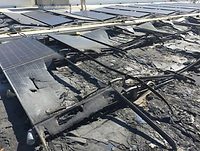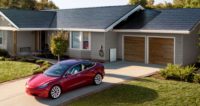Tesla CEO Claims ‘Significant Mistakes’ Made with Solar Roof

Photo courtesy of Tesla, Inc.
Tesla CEO Elon Musk said the company made “significant mistakes” with its Solar Roof product that is resulting in large price increases for customers.
In the company’s Q1 2021 earnings call on Monday, Musk said demand for the Solar Roof product remains strong despite recent price changes, but the company is struggling to keep up with that demand.
“Production has gone fine, but we are choked at the installation point,” Musk said. “We did find that we basically made some significant mistakes in assessing the difficulty of certain roofs, but the complexity of roofs varies dramatically.”
These complexities, he said, range from roofs with multiple protuberances to the core roof not being strong enough to hold the Solar Roof, creating what outlets like Electrek reported as a Tesla’s new “complexity factor.” Musk explained that due to these complexities, the cost for the roof can be two or three times what Tesla initially quoted. Electrek reported that some homeowners are facing tens of thousands more dollars.
Musk said customers who aren’t happy with the price hikes can have their deposits refunded. The company is also starting to offer free Powerwalls to those customers. Powerwall is Tesla’s rechargeable home battery designed to store solar energy for self-consumption, during outages or off-the-grid use.
Last week, Musk announced via Twitter that Tesla’s Solar Roof and solar panels will only be sold as an integrated product with Powerwall.
“The difficulty of the installation will be much easier because power from the Solarglass Roof or the panels will only ever go directly into the Powerwall, and the Powerwall will only ever go between the utility and the main power panel of the house,” he said. “Effectively, almost every house therefore looks the same electrically instead of being a unique work of art … this is extremely important for scalability.”
He added that the Powerwall, combined with solar products, would allow homes to help utility companies stabilize the overall grid and mitigate issues like what recently happened in Texas when winter storms caused massive outages.
“By having a battery storage paired with solar and wind, this gives the long-term solution to a stable energy future,” he said.
The call wasn’t all glum news for Tesla’s solar products. The company deployed 92 megawatts of solar in the first quarter, a 163% increase when compared to the same time last year. In Q4 2020, Tesla deployed 86 megawatts.
Tesla first introduced the Solar Roof in 2016, though it hasn’t been a smooth road for the company. Pre-orders were accepted in 2017, though Tesla hit snags testing the longevity of the roof, updating its design until releasing Version 3 in 2019. Most recently, due to the pandemic, solar deployment declined in the second quarter of 2020. In June 2020, the company canceled Solar Roof orders with certain customers because their homes weren’t in an area covered by Tesla.
The Tesla Solar Roof uses glass tiles embedded with solar cells to provide power to a home, serving as a replacement for more traditional solar panel systems. The company has been ramping up efforts to hire installers around the country as well as posting for positions in Canada.
Looking for a reprint of this article?
From high-res PDFs to custom plaques, order your copy today!







